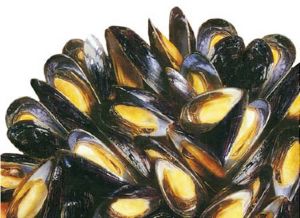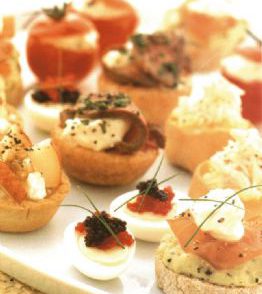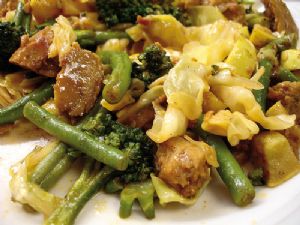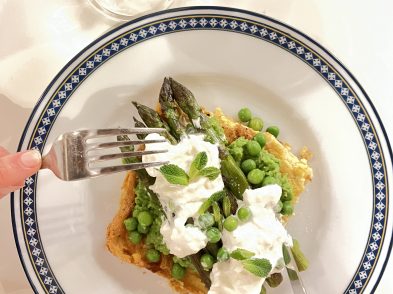So, you’ve spent the whole of January taking it easy, saving money and cranking your health back up to pre-Christmas levels. And you’ve spent February huddled up against (what we hope is) the last of the wintry weather, eking a few tasty meals out of the last, cheap ingredients of the winter season, and settling into the swing of 2009. Now it’s March. You’ve saved some cash, spring is just around the corner, and you can get back to enjoying yourself again. Isn’t it time to get into the kitchen and make the most of the new crops of ingredients?
Rather than spending all of your money on food, you might find that a couple of bits of new kitchen equipment make for a prudent investment. I’m not talking about anything too expensive, nor any electrically powered gadgets that will be wheeled out once a year and spend the rest of their existence stuck in the cupboard above the fridge, gathering that curious patina of greasy dust that unused and unloved utensils in the kitchen seem to conjure out of nowhere and that I think might be made out of dark matter.
No, it’s far better to buy something that might improve your skills and increase your deftness, that won’t be difficult to clean, that won’t break the bank and that you might find yourself using fairly frequently. None of these pieces of kit will cost much money, and you can incorporate them into your food preparation routine easily. You may even find yourself wondering what you did without them. (Admittedly, you may have better things to wonder about, so you might not.)
Along with a good, sharp knife, one of the most useful things that you can buy for your kitchen is a mandolin (alternatively known as a mandoline). You’ve almost certainly seen them and have probably used them before: they are a pimped-out version of the ‘food slicer’ available commonly and cheaply, with the principal differences being that (a) the blade is straight, not set at an angle, and (b) the thickness of slices can be adjusted by a screw, lever or ratchet. You can slice 1mm-thick potato chips or 1cm-thick onion rings, and most things in between. Many also come with an attachment or two which enable you to cut matchstick-or pommes frites-sized batons: these look like tiny attachable combs made of blades which slot into the instrument.
Once you have one, food preparation becomes a breeze: a risky breeze, mind, as the instruments tend to contain an ultra-sharp blade that is set very close to where your hand will be gripping the vegetables you’re slicing. Every cook can tell you stories of the time that he or she sliced the tip off a finger on one of these things: please, please be careful if you use one. But if you master the mandolin and make most of the grips or guards many of them come with, you’ll find yourself churning out gratins and tarts of thinly sliced fruit and veggies in minutes. Salads become incredibly easy; garnish, too, can be made much more interesting by slicing carrots and other brightly coloured veggies into batons and using them to dress your dish or plate.
Another key piece of equipment is a food mill: commonly a heat-proof bowl with a removable bottom, which is fashioned like a sort circular grater-sieve. Into this, you fit a metal blade, attached to an axle with a handle. Cooked food, placed in this, is pushed through the grater-sieve by the blade as you turn the handle, making purees in seconds. A food mill has the beneficial effect of filtering the slightly tougher bits of food-tomato and pepper skins, celery ribs, and so on. It is ideal for making mashes, soups and bases for stews. For example, slow-roasted tomatoes and onions in sauce, once passed through a food mill, become a very rich, deeply flavoured sauce base into which you can add other, more delicate ingredients to. Make pea or spinach puree to use as a base for pan-fried white fish dishes. Or, cook celeriac, parsnips, swede or chickpeas with potatoes and pass them through the food mill for a delicate mash into which you can stir herbs and spices.
Finally, you may want to invest in a food thermometer. This-and the accompanying chart that describes how hot meat and fish should be in order to be cooked to perfection-will ensure that you never mis-roast or serve undercooked food again. There’s little more frustrating than cutting into a piece of beef to discover that it’s not cooked to your liking: these ultra-cheap gadgets will put a stop to that happening and also ensure that more delicate dishes, such as wrapped or herb-crusted pieces of fish) aren’t cooked until the other ingredients they’re combined with are burnt to a crisp.
Try to pick these up and see the difference that they make to your cooking and preparation; and let us know how you get on. Before long, you’ll be emulating the molecular gastronomists and making toast in the Large Hadron Collider. Everybody has to start somewhere.
Recipe of the fortnight: CUSTARD TART
For the pastry:
100g softened butter
200g flour
20g fine sugar
A pinch of salt
A little cold water
For the custard:
3 large eggs, plus 2 egg yolks, beaten lightly in a bowl
550ml double cream
50g fine sugar
Half of a vanilla pod, split and with the seeds scraped out, or half a teaspoon of vanilla essence
Sift the flour into a bowl with the salt and sugar. Add the butter, and using the tips of your fingers, rub the ingredients together until the mixture is golden brown and resembles breadcrumbs. Now, add water a splash at a time, mixing it well in, to form a smooth pastry: not too sticky. You will need about a spoonful or two of water, so don’t overdo it. Knead lightly for a short time to ensure a good mix, then wrap the pastry in clingfilm and chill it for an hour or so.
Roll the pastry out and line a fairly deep dish with it (4-5cm deep, 16-17cm across, or as close as possible). Now, brush it with a small amount of the beaten egg and “blind bake” in a hot oven for 10-12 minutes, until a light glaze has formed. This stops the filling from making the pastry soggy.
Place the cream in a small pan and add the vanilla pod: you can scrape the seeds into the liquid first (alternatively, add the essence). Bring to a gentle simmer and then remove from the heat. In a separate bowl, lightly whisk the beaten eggs with the sugar. Sieve the cream through a fine mesh to remove the vanilla pod and seeds, then add this to the egg and sugar mix and whisk gently again. Set aside.
Pour the custard into the pastry case, making sure that you don’t overfill (leave a couple of mm at the top of the dish). Bake in an oven at 170° C for 35 minutes or until the filling is firm and golden brown.







